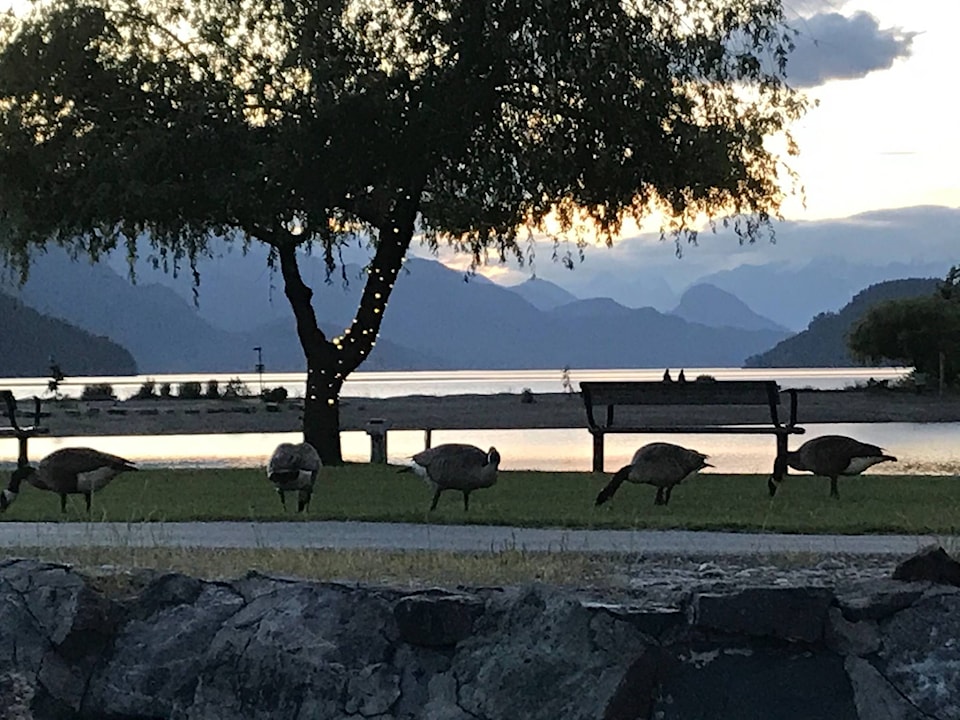Sometimes the most compelling journalism comes from asking the questions to which no one knew they wanted the answers.
Whether or not this editorial falls under such a prestigious umbrella is up to you. Here, I document my journey to answer one of the most useless local hypotheticals I can think of – just how many Canada geese would it take to fill Harrison Lake?
Problem 1: the first thing to consider is the goose itself. There are seven recognized subspecies, according to Ducks Unlimited: Atlantic, Hudson’s Bay, Giant, Moffitt’s, Lesser, Dusky and Vancouver. As I am an amateur ornithologist at best, I’m going to do the mathematically efficient thing and just go by the average size of a Canada goose rather than worrying about subspecies. For the particular dimensions we’re looking for, I find it’s easier to measure a standing, full-body decoy. This gives us a 33 x 17 x 17-inch goose, which lines up decently with measurements from a number of sources. Converted to feet, you have approximately 5.39 cubic feet of goose.
You might say, “Adam, that’s cheating.” To that I can only respond, “No, it’s science.”
Problem 2 arises. Geometrically speaking, geese have an odd shape. This puts forth a new dimension (no pun intended) to the problem in that we may need to factor in a goose-stacking configuration to achieve the highest possible volume. The engineering, physics and math involved in putting together uniquely-shaped geese in a feasible structure so as to fill the lake is beyond my scope of knowledge and the allowable length of this column.
For simplicity, we will put each goose in a cube, assuming the cube to be structurally sound, comfortable and equipped to quell the stress of the bird long enough to carry out this hypothetical. They’ll all be released when we’re done.
We have the dimensions and a theoretical uniform shape of the goose cubes. Now we move on to problem 3 – Harrison Lake. For the sake of this hypothetical, the lake will be drained dry; it would just be geese all the way down.
B.C. Adventure Network clocks Harrison Lake at having a mean depth of 492 feet. A quick Google search puts the lake’s area at 218 square kilometres, which converted into imperial for the sake of this arguement is 715, 223 square feet. Multiply this by the mean depth to get a very rough estimate of the lake’s volume, divide that by the volume of the goose…
The answer is 65,285,661 Canada geese.
I realize in coming with the answer, we’ve created an impossibility for ourselves in making a uniform shape in which to deposit our uniform goose cubes for our mad science experiment. It’s by no means a hard science, but in the end, it’s all about getting some perspective on the sheer size of one of the Fraser Valley’s most recognizeable landmarks.
This column is less about proving the answer to a surreal question so much as how I got there and the fun we had along the way. One of the best parts of being alive is being able to pursue knowledge and questions to satisfy our curiosities. Yes, the question itself is ridiculous but in looking back, is it really a useless question? After all, it’s in answering this question that I entertained you and I entertained myself.
In pursuing such a silly scenario to the furthest degree, we’ve imbued this otherwise passing thought with a purpose, and adding purpose where once there was none is a truly remarkable thing.
@adamEditor18
adam.louis@ ahobserver.com
Like us on Facebook and follow us on Twitter.
